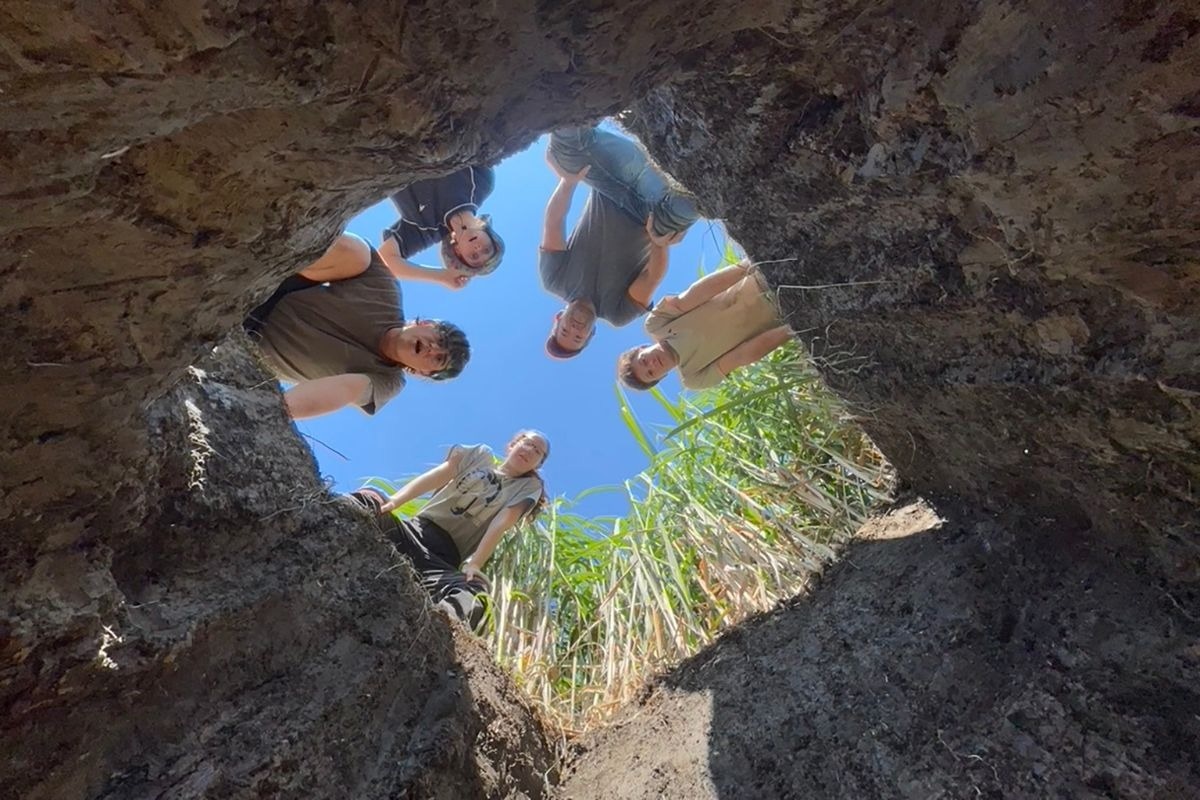According to a West Virginia University scientist, the quest for sustainable bioenergy and solutions to climate change may be indistinguishable.
 Members of the Brzostek Lab at West Virginia University marvel at the soil pit they dug to measure how miscanthus roots and soil microbes contribute to forming long-lived deep soil carbon. Pictured are Noah Wauls, undergraduate student; Edward Brzostek, Associate Professor of Biology; Jessica Burke, Undergraduate Student; Dominick Cifelli, Master’s Student; and Zoe Pagliaro, Doctoral Student. Image Credit: West Virginia University.
Members of the Brzostek Lab at West Virginia University marvel at the soil pit they dug to measure how miscanthus roots and soil microbes contribute to forming long-lived deep soil carbon. Pictured are Noah Wauls, undergraduate student; Edward Brzostek, Associate Professor of Biology; Jessica Burke, Undergraduate Student; Dominick Cifelli, Master’s Student; and Zoe Pagliaro, Doctoral Student. Image Credit: West Virginia University.
Through a renewed five-year grant from the US Department of Energy, Edward Brzostek, Associate Professor of Biology, and his students at WVU’s Eberly College of Arts and Sciences are developing mathematical models to anticipate how bioenergy crops will increase and store soil carbon.
Brzostek believes the models could provide a “win-win” situation that not only enhances soil carbon but also stimulates sustainable bioenergy from biological sources. Biofuels such as corn ethanol and perennial grasses are examples of this.
In Brzostek’s model, soil microbes control how plants may store or release carbon in the future. That is something that existing models do not take into account.
Our model can predict whether a bioenergy crop is going to be a net carbon benefit or actually result in carbon losses.
Edward Brzostek, Associate Professor, Biology, West Virginia University
Variables include whether or not living roots increase or decrease carbon in the soil, as well as how the processes differ with depth and feedstock differences.
Natural climate solutions, such as regenerative agriculture, can aid in mitigating the effects of climate change. Brzostek’s goal is to figure out the best strategy to promote the expansion of biofuel sources while also cleaning up the environment.
We don't need any new technology to do this. It’s one of the few ways that you can get carbon dioxide out of the atmosphere. The holy grail of bioenergy crops is to make products or fuel while also storing more carbon in the ecosystem. If you can grow a biofuel that enhances soil carbon, that’s a win-win.
Edward Brzostek, Associate Professor, Biology, West Virginia University
Plants naturally capture and store carbon, which they absorb through photosynthesis. The leaf litter and dead root material remain in the soil when the plant dies. The decaying substance is then decomposed by various entities, the vast majority of which are bacteria and fungi. Their byproducts, including carbon, persist in the soil when they die.
It’s like a microbial funnel. And a lot of the questions that we’re asking about soil carbon storage, agricultural management, and predicting soil carbon into the future are germane to any ecosystem. They’re fundamental questions in ecology that are important to understanding whether our ecosystems can keep the carbon they have and potentially take up more.
Edward Brzostek, Associate Professor, Biology, West Virginia University
The researchers are also investigating how plants help themselves.
Brzostek explains, “There’s this growing idea that plants can engineer their soil environment by doing things with their roots. They can leak carbon out of their roots that feed the microbes. That makes the microbes happy. They break down soil carbon and then they give the plant nitrogen in return, which it needs to grow.”
So far, research has shown that miscanthus roots can harvest nitrogen from leaf litter without causing carbon loss.
Microbes play an important role in the process. Fortunately, they are everywhere.
Brzostek adds, “When you walk out in the forest in West Virginia, the microbes are eating everything. If they weren’t, you’d be drowning in leaf litter.”
His study is being conducted through the Center of Advanced Biofuels and Bioproducts Innovation, which was founded by the US Department of Energy in 2017. CABBI, based at the University of Illinois, brings together 20 partner institutions, universities, and national laboratories to do research on sustainable bioproducts derived from bioenergy crops.
It is difficult to decarbonize the economy. Renewable energy sources include wind, solar, and nuclear power, however, some industries, such as aviation, cannot be decarbonized.
Brzostek concludes, “Bioenergy can play a part in the new bioeconomy. We talk about bioenergy refineries and plants that could produce energy from some bioenergy crop. They’d capture the carbon dioxide and pump it underground. It could lead to a new green industry across much of the rain-fed United States, where you can grow these things.”
Brzostek was assisted by WVU students and postdoctoral researchers Joanna Ridgeway, Zoe Pagliaro, Dominick Cifelli, Jessica Burke, Noah Wauls, and Stephanie Juice.